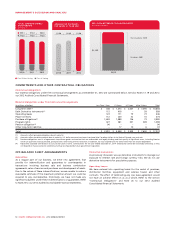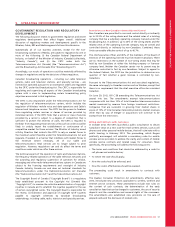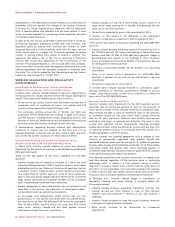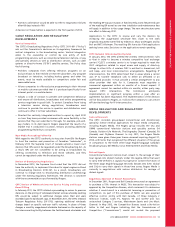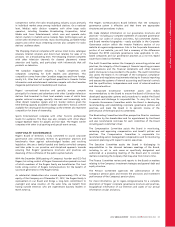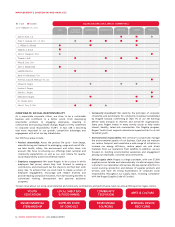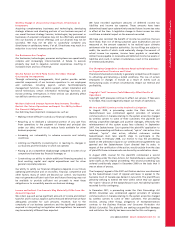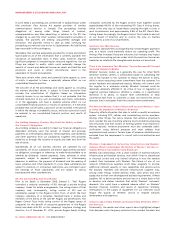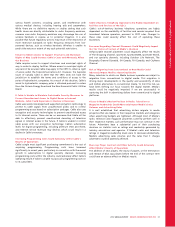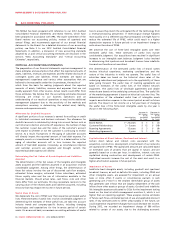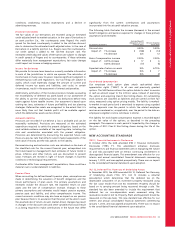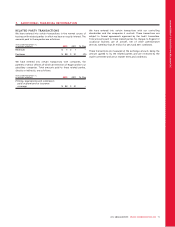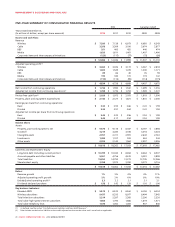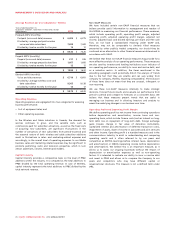Rogers 2012 Annual Report Download - page 68
Download and view the complete annual report
Please find page 68 of the 2012 Rogers annual report below. You can navigate through the pages in the report by either clicking on the pages listed below, or by using the keyword search tool below to find specific information within the annual report.MANAGEMENT’S DISCUSSION AND ANALYSIS
In addition, the CRTC Broadcasting Distribution Regulations do not
allow Cable or its competitors to obtain exclusive contracts in
buildings where it is technically feasible to install two or more
systems.
We Are Subject to Various Risks from Competing Technologies
There are several technologies that may impact the way in which our
services are delivered. These technologies include broadband, IP-
based voice, data and video delivery services; the mass market
deployment of optical fibre technologies to the residential and
business markets; the deployment of broadband wireless access and
wireless services using a radio frequency spectrum to which we may
have limited access. These technologies may result in significantly
different cost structures for the users of the technologies and may
consequently affect the long-term viability of certain of our currently
deployed technologies. Some of these new technologies may allow
competitors to enter our markets with similar products or services
that may have lower cost structures. Some of these competitors may
be larger, with greater access to financial resources than we have.
Improvements in the quality of streaming video over the Internet,
coupled with the increasing availability of television shows and
movies online increases competition to Canadian cable television
systems. If changes in technology are made to any alternative
Canadian multi-channel broadcasting distribution system,
competition with our cable services may increase. In addition, as
improvements in technology are made with respect to wireless
Internet, it increasingly becomes a substitute for the traditional
wireline Internet service.
The increasing utilization of PVRs could influence Media’s capability
to generate television advertising revenues, as viewers are provided
with the opportunity to skip advertising aired on the television
networks. The emergence of subscriber-based satellite and digital
radio products could change radio audience listening habits and
negatively impact the results of Media’s radio stations. Certain
audiences are also migrating to the Internet as more video and audio
content becomes available.
We Are Highly Dependent upon Our Information Technology
Systems
The day-to-day operations of our businesses are highly dependent on
their information technology systems. An inability to operate or
enhance information technology systems to accommodate additional
customer growth and support new products and services could have
an adverse impact on our ability to acquire new subscribers, manage
subscriber churn, produce accurate and timely subscriber invoices,
generate revenue growth and manage operating expenses, all of
which could adversely impact our financial results and position.
In addition, we use industry-standard network and information
technology security, survivability and disaster recovery practices. Our
ongoing success is in part dependent on the protection of our
corporate-business-sensitive data, including our customers’ as well as
employees’ personal information. This information is considered
company intellectual property and it needs to be protected from
unauthorized access and compromise for which we rely on policies
and procedures as well as IT systems. Failure to secure our data and
the privacy of our customer information may result in non-compliance
with regulatory standards and may lead to negative publicity,
litigation and reputation damage, any of which may result in
customer losses, financial losses and an erosion of public confidence.
Most of our employees and critical elements of the network
infrastructure and information technology systems are concentrated
in three Ontario locations: our corporate offices in Toronto and
Brampton, and an operations facility in Markham. In the event that
we cannot access these facilities, as a result of a natural or manmade
disaster or otherwise, our operations may be significantly affected
and may result in a condition that is beyond the scope of our ability
to recover without significant service interruption and commensurate
revenue and customer loss.
Network Failures Could Reduce Revenue and Impact Customer
Service
The failure of our networks or key network components could, in
some circumstances, result in an indefinite loss of service for our
customers and could adversely impact our financial results and
position. In addition, we rely on business partners to carry certain of
our customers’ traffic. The failure of one of these carriers might also
cause an interruption in service for our customers that would last
until we could reroute the traffic to an alternative carrier.
Changes in Government Regulations Could Adversely Affect Our
Results
As described in the section of this MD&A “Government Regulation
and Regulatory Developments”, substantially all of our business
activities are regulated by Industry Canada and/or the CRTC. As such,
regulatory changes or decisions made by these regulators could
adversely impact our results of operations on a consolidated basis.
This regulation relates to, among other things, licencing, competition,
the cable television programming services that we must distribute,
wireless and wireline interconnection agreements, the rates we may
charge to provide access to our network by third parties, the resale of
our networks and roaming on our networks, our operation and
ownership of communications systems and our ability to acquire an
interest in other communications systems. In addition, the costs of
providing services may be increased from time-to-time as a result of
compliance with industry or legislative initiatives to address consumer
protection concerns or such Internet-related issues as copyright
infringement, unsolicited commercial e-mail, cybercrime and lawful
access. Our cable, wireless and broadcasting licences may not
generally be transferred without regulatory approval.
Generally, our licences are granted for a specified term and are
subject to conditions on the maintenance of these licences. These
licencing conditions may be modified at any time by the regulators.
The regulators may decide not to renew a licence when it expires, and
any failure by us to comply with the conditions on the maintenance
of a licence could result in a revocation or forfeiture of any of our
licences or the imposition of fines.
The licences include conditions requiring us to comply with Canadian
ownership restrictions of the applicable legislation. We are currently
in compliance with all of these Canadian ownership and control
requirements. However, if these requirements are violated, we would
be subject to various penalties, possibly including, in the extreme
case, the loss of a licence.
We May Fail to Achieve Expected Revenue Growth from New and
Advanced Services
We expect that a substantial portion of our future revenue growth
may be achieved from new and advanced services. Accordingly, we
have invested and continue to invest significant capital resources in
the development of our networks in order to offer these services.
However, there may not be sufficient consumer demand for these
new and advanced services. Alternatively, we may fail to anticipate or
satisfy demand for certain products and services, or may not be able
to offer or market these new products and services successfully to
subscribers. The failure to profitably attract subscribers to new
products and services, or failure to keep pace with changing
consumer preferences for products and services, would slow revenue
growth and increase churn and could have a materially adverse effect
on our business, results of operations and financial condition.
64 ROGERS COMMUNICATIONS INC. 2012 ANNUAL REPORT




